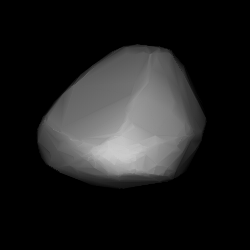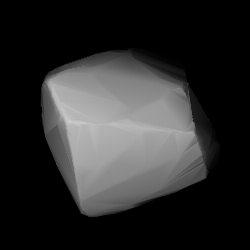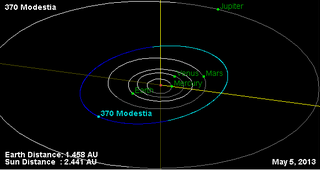
Vincentina is a fairly large main belt asteroid.

Rosalia is a large Main belt asteroid. It was discovered by Auguste Charlois on 1 September 1891 in Nice.

Gisela is an asteroid belonging to the Flora family in the Main Belt that has an unusually high albedo.

353 Ruperto-Carola is a background asteroid from the central region of the asteroid belt. It was discovered by German astronomer Max Wolf at the Heidelberg Observatory on 16 January 1893. It is named after the Ruprecht Karls University, whose Latin name is Ruperto Carola Heidelbergensis.

Gabriella is a typical Main belt asteroid.

Ninina is a large main-belt asteroid. It was discovered by Auguste Charlois on February 11, 1893, in Nice. The reference of its name is not known, though Ninine is a French personal name.

Apolonia is a large Main belt asteroid. It was discovered by Auguste Charlois on 8 March 1893 in Nice.

Georgia is a typical Main belt asteroid. It is classified as an X-type asteroid.

360 Carlova is a very large main-belt asteroid. It is classified as a C-type asteroid and is probably composed of carbonaceous material. The asteroid has a convex, roughly ellipsoid shape. The sidereal rotation period is 6.1873 hours with an axis of rotation along the ecliptic coordinates (l, b) = (95°±3°, 40°±1°). It was discovered by Auguste Charlois on 11 March 1893 in Nice.

361 Bononia is a very large, resonant Hilda asteroid located in the outermost region of the asteroid belt. It is classified as a D-type asteroid and is probably composed of organic rich silicates, carbon and anhydrous silicates. It was discovered by Auguste Charlois on 11 March 1893, in Nice, and assigned the prov. designations A893 EF and 1893 P.

Havnia is a typical Main belt asteroid.

Amicitia is a typical Main belt asteroid that is a member of the Flora family. It was discovered by Auguste Charlois on 19 May 1893 in Nice.

Haidea is a large asteroid residing in the asteroid belt. It was discovered by Auguste Charlois on 19 May 1893 in Nice.

Modestia is probably a typical Main belt asteroid. It was discovered by Auguste Charlois on 14 July 1893 in Nice.

373 Melusina is a large Main belt asteroid. It is classified as a C-type asteroid and is probably composed of carbonaceous material. It was discovered by Auguste Charlois on 15 September 1893 in Nice.

Burgundia is a typical main belt asteroid that was discovered by Auguste Charlois on 18 September 1893 in Nice. It was named for the former French region of Burgundy. It is one of seven of Charlois's discoveries that was expressly named by the Astromomisches Rechen-Institut.

Geometria is a main belt asteroid that was discovered by French astronomer Auguste Charlois on 18 September 1893 in Nice, France. It is classified as an S-type asteroid.

Campania is a large main belt asteroid that was discovered by French astronomer Auguste Charlois on 20 September 1893 in Nice.

Holmia is a typical Main belt asteroid.
2013 PJ10 is a Near-Earth asteroid that was discovered on 4 August 2013 in Observatorio Astronómico de La Sagra, with an estimated diameter of about 50 meters. At 02.18 GMT, 4 August 2013, this asteroid flew at a minimum distance from the Earth (371.4 thousand kilometers), accounting for 0.96 average radius of the lunar orbit, but until 2180 it will not approach the Earth closer than 3.2 million miles.



















